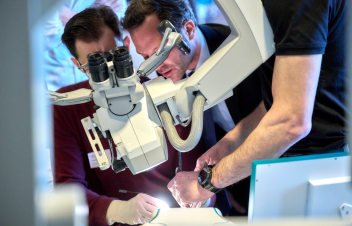The Future of Medical Software: Key Features to Watch
- surgeonslab1
- May 10, 2024
- 4 min read
The appearance of medical software has greatly changed the traditional paradigm of modern healthcare. From streamlining administrative tasks to contributing to the development of leading-edge diagnosis tools, these digital solutions play a major role in patient care and education. This article delves into the exciting future of medical software features, focusing on key features poised to revolutionize surgical training: sophisticated neurosurgical and radiology simulators.

The Current Landscape of Medical Software
Through the practices of medical software, healthcare has experienced remarkable development. With electronic health records (EHR) in place, apart from patient information being centrally available to all providers, care coordination and medication management can also be improved. The software with advanced imaging helps medical experts pinpoint the problem, and the planning tools for the treatment help come up with personalized strategies. Despite this, the medical software's power is not only present in the impactful role of simulators for the advancement of the future of medical professional training.
Advanced Features in Neurosurgical Simulators
Neurosurgical operations are very complex, requiring a high level of attention to accuracy and spatial awareness. The future of the neurosurgical simulator industry depends on the ability to use the latest technologies:
VR and AR Integration: Virtual reality (VR) brings the benefit of simulating the operating room virtually and, therefore, creates an optimal environment in which trainees can develop techniques in a safe, controlled setting. AR allows surgeons to have complex data overlaid onto an exact patient's anatomy during a procedure, which can be extremely helpful in real-time operations.
Haptic Feedback: The realistic haptic feedback mimics the sensations of manualizing tissues and surgical instruments during operations. This sensory feedback improves the training experience and enables the surgeons to develop the necessary motor skills for thorough operations.
Personalized Training Scenarios: In advanced simulators, 3D virtual models may include patient-specific anatomy and pathology, which would give trainees an opportunity to practice on the virtual models close to real-life cases. This individualized approach improves instructional efficacy and prepares surgeons for a more complicated set of situations.
Predictive Analytics: Machine simulators with incorporated predictive analytics are creating a unique opportunity for students to try different surgical methods and have a virtual visualization of possible outcomes. This eliminates wasting time searching, improves decision-making during operations, and increases the overall surgical success rate.
Innovations in Radiology Simulators
Radiology plays a crucial role in medical diagnosis, requiring physicians to interpret complex medical images. Radiology simulator of the future will leverage advanced technologies to enhance this process:
AI-Driven Image Interpretation
AI algorithms can make medical image analysis and detect abnormalities and pathologies much easier for radiologists. This will improve diagnostic accuracy and eliminate the paperwork that radiologists deal with.
Enhanced 3D Visualization
Advanced imaging modes with 3D visualization capabilities provide radiologists with a more detailed view of conditions and anatomical structures, helping them to locate and analyze even subtle abnormalities with a higher degree of accuracy.
Real-Time Collaboration
With the latest radiology simulator, radiationists can achieve actual-time collaboration, in which radiologists can talk to each other across the globe without physically visiting, thereby facilitating the sharing of expertise.
Machine Learning for Pattern Recognition
Machine learning algorithms could also be used to develop radiology simulators with the ability to detect specific image patterns locally, which will be useful for disease early identification and the improvement of patients' outcomes.
Interoperability and Integration
The flexibility of these advanced features requires a higher level of interoperability as different programs exchange data. The unification of data formats through standardized medical records and imaging channels will enhance data-sharing capabilities between simulators and EHRs, as well as within other software applications. Such an approach creates a more comprehensive perception and benefits the workplace within healthcare facilities.
Security and Compliance
With the advancement of medical software, the number of data privacy and security problems has elevated proportionally. Highly secure encryption and access control procedures are necessary for the protection of confidential patient data. Moreover, the software developers' medical software must also strictly adhere to healthcare regulations and standards to guarantee the protection of patient data.
Key Takeaway
The future of medical software is very promising. The inclusion of advanced medical software features like virtual reality and augmented reality integration, haptic feedback, and AI-powered diagnostics has the potential to radically alter the medical training process, resulting in improvement of patient outcomes. If, through constant development and integration of these advanced technologies, the healthcare industry will be able to create a situation where healthcare providers will have better means to give excellent care.
FAQs
What benefits does haptic feedback provide in surgical simulations?
VR in neurosurgical training provides trainees with realistic and risk-free environments that improve their spatial awareness and let them develop a variety of surgical skills.
2. Can neurosurgical simulators offer personalized training?
Yes, neurosurgical simulators can create patient-specific scenarios, allowing surgeons to practice on anatomically accurate models and enhancing surgical preparedness.
3. How does AI improve radiology diagnostics?
AI in radiology diagnostics assists in analyzing complex images, increasing accuracy, and enabling earlier disease detection.
4. What measures ensure security in medical software?
Medical software security is ensured through robust encryption, strict access controls, and adherence to healthcare regulations to protect patient data.







